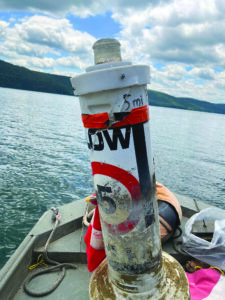Letter from Paul H. Lord
Hit and run at
5 Mile Point

I received a report on Monday morning that someone had observed “a pontoon boat run over the 5 Mile Point no wake buoy” which subsequently “sunk!”
On Friday morning, we assembled a team of two faculty members and three students and investigated the 5-mile Point buoy location (which is 105′ deep; a challenging dive).
I found the buoy on the bottom, attached a lift bag and brought it up to within 20′ of the surface where, upon inspection, we found what is depicted in the attached photo. We have never seen such damage to one of our buoys from a single impact.
The pontoon boat driver was obviously ignoring the no-wake zone requirement and failed to report (to my knowledge) the accident which cost between $700 and $900 to repair (depending on whether items lost and destroyed in the recovery are included). Those costs, of course, do not include the time invested by the five of us doing the recovery and replacement work and includes no charge for the boat use. We swapped out the buoy. The destroyed buoy retrieved from the bottom of Otsego Lake is now at the SUNY Oneonta Biological Field Station Boathouse (7016 State Highway 80), at the water’s edge, for anyone who might want to inspect it.
Our lake is for our enjoyment. All of us who love the lake need to keep it safe for others. If anyone
has any information regarding this incident, either witnessing it or notice a pontoon boat with a damaged bow, I ask that you call the Sheriff’s Office at 607-547-1690.
Paul H. Lord
Biological Field Station


Throughout New York State, vessel speed is generally limited to 5 mph when you are within 100 feet of the shore, dock, pier, raft, float, or anchored boat. On some specific bodies of water the 5 mph limit has been extended to 200 feet, and there may be a 45 mph daytime and 25 mph night time speed limit
*Goodyear Lake and river also.*88
Throughout New York State, vessel speed is generally limited to 5 mph when you are within 100 feet of the shore, dock, pier, raft, float, or anchored boat. On some specific bodies of water the 5 mph limit has been extended to 200 feet, and there may be a 45 mph daytime and 25 mph night time speed limit
*Goodyear Lake and river also.*88
Throughout New York State, vessel speed is generally limited to 5 mph when you are within 100 feet of the shore, dock, pier, raft, float, or anchored boat. On some specific bodies of water the 5 mph limit has been extended to 200 feet, and there may be a 45 mph daytime and 25 mph night time speed limit
*Goodyear Lake and river also.*
Throughout New York State, vessel speed is generally limited to 5 mph when you are within 100 feet of the shore, dock, pier, raft, float, or anchored boat. On some specific bodies of water the 5 mph limit has been extended to 200 feet, and there may be a 45 mph daytime and 25 mph night time speed limit
*Goodyear Lake and river also.*